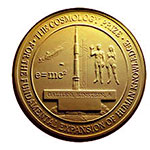Wilkinson Microwave Anisotropy Probe
The Wilkinson Microwave Anisotropy Probe (WMAP) is a NASA Explorer mission that launched June 2001 to make fundamental measurements of cosmology -- the study of the properties of our universe as a whole. WMAP has been stunningly successful, producing our new Standard Model of Cosmology. WMAP's data stream has ended.
Full analysis of the data is now complete.Publications have been submitted as of 12/20/2012.
WMAP TEAM RECEIVES THE 2012 GRUBER COSMOLOGY PRIZE
"The Gruber Foundation proudly presents the 2012 Cosmology Prize to Charles Bennett and the Wilkinson Microwave Anisotropy Probe team for their exquisite measurements of anisotropies in the relic radiation from the Big Bang---the Cosmic Microwave Background. These measurements have helped to secure rigorous constraints on the origin, content, age, and geometry of the Universe, transforming our current paradigm of structure formation from appealing scenario into precise science."
Other Members of the WMAP team are:
Chris Barnes, Rachel Bean, Olivier Doré, Joanna Dunkley, Benjamin M. Gold, Michael Greason, Mark Halpern, Robert Hill, Gary F. Hinshaw, Norman Jarosik, Alan Kogut, Eiichiro Komatsu, David Larson, Michele Limon, Stephan S. Meyer, Michael R. Nolta, Nils Odegard, Lyman Page, Hiranya V. Peiris, Kendrick Smith, David N. Spergel, Greg S. Tucker, Licia Verde, Janet L. Weiland, Edward Wollack, and Edward L. (Ned) Wright.
For more information about the prize visit:
2012 Gruber Cosmology Prize Press Release
WMAP's Top Ten
The WMAP science team has…
- ... has put the "precision" in "precision cosmology" by reducing the allowed volume of cosmological parameters by a factor in excess of 68,000. The three most highly cited physics and astronomy papers published in the new millennium are WMAP scientific papers--- reflecting WMAP's enormous impact.
- …mapped the pattern of tiny fluctuations in the Cosmic Microwave Background (CMB) radiation (the oldest light in the universe) and produced the first fine-resolution (0.2 degree) full-sky map of the microwave sky.
- …determined the universe to be 13.77 billion years old to within a half percent.
- …nailed down the curvature of space to within 0.4% of "flat" Euclidean.
- …determined that ordinary atoms (also called baryons) make up only 4.6% of the universe.
- …completed a census of the universe and finds that dark matter (matter not made up of atoms) is 24.0%
- …determined that dark energy, in the form of a cosmological constant, makes up 71.4% of the universe, causing the expansion rate of the universe to speed up. - "Lingering doubts about the existence of dark energy and the composition of the universe dissolved when the WMAP satellite took the most detailed picture ever of the cosmic microwave background (CMB)." -Science Magazine 2003, "Breakthrough of the Year" article
- … mapped the polarization of the microwave radiation over the full sky and discovered that the universe was reionized earlier than previously believed. - "WMAP scores on large-scale structure. By measuring the polarization in the CMB it is possible to look at the amplitude of the fluctuations of density in the universe that produced the first galaxies. That is a real breakthrough in our understanding of the origin of structure." - ScienceWatch: "What's Hot in Physics", Simon Mitton, Mar./Apr. 2008.
- …detected that the amplitude of the variations in the density of the universe on big scales is slightly larger than smaller scales. This, along with other results, supports "inflation", the idea is that the universe underwent a dramatic period of expansion, growing by more than a trillion trillion fold in less than a trillionth of a trillionth of a second. Tiny fluctuations were generated during this expansion that eventually grew to form galaxies.
- … determined that the distribution of these fluctuations follows a bell curve with the same properties across the sky, and that there are equal numbers of hot and cold spots in the map. The simplest version of the inflation idea predicted these properties and remarkably, WMAP’s precision measurement of the properties of the fluctuations has confirmed these predictions, in detail.
http://map.gsfc.nasa.gov/



